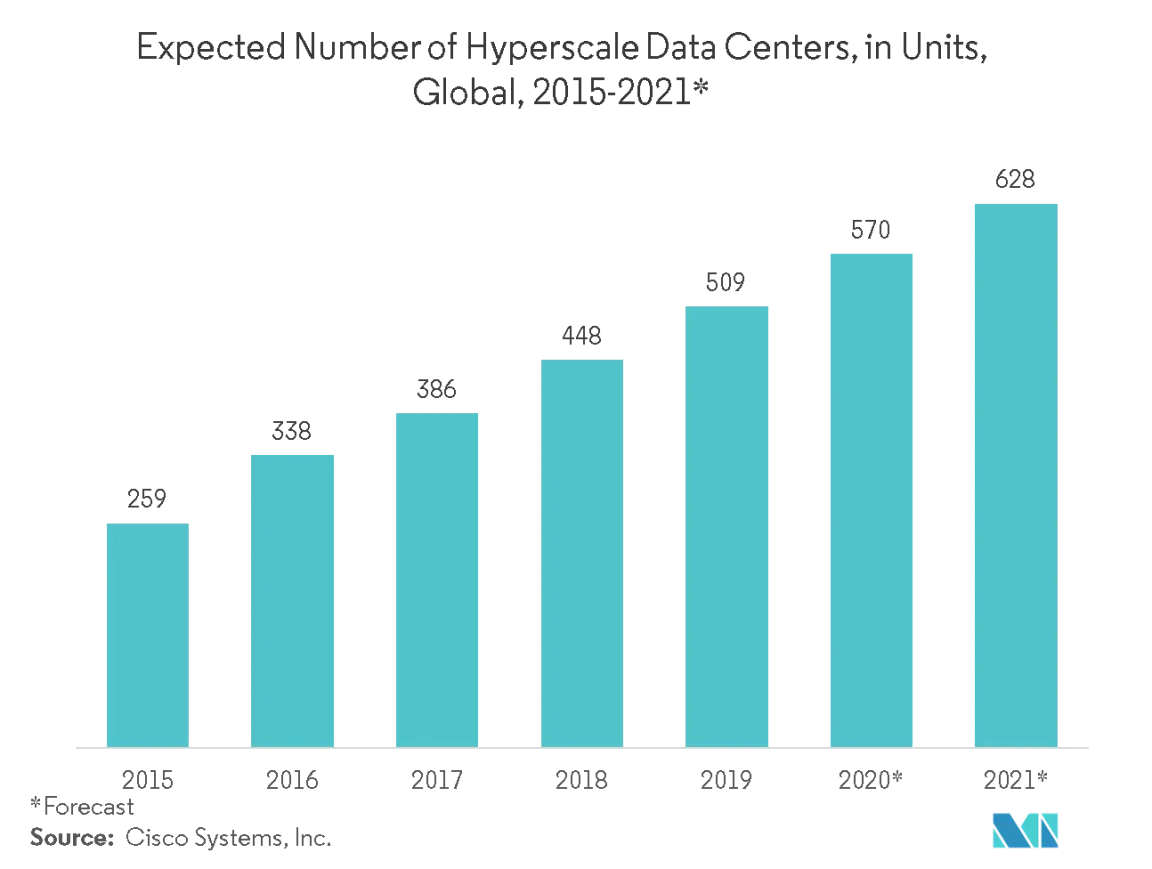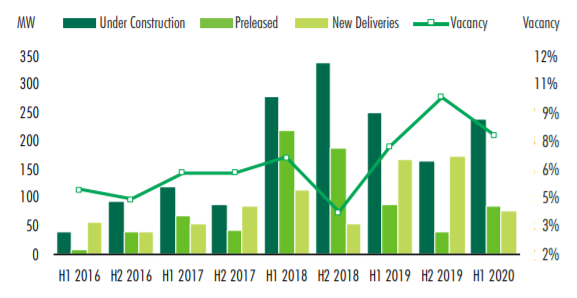How Ashburn, VA became the Colocation Mecca known as Data Center Alley
How did Ashburn, Virginia come to host 70% of the world’s internet traffic? Here we discuss the past, present and future of Data Center Alley.

Nov 13, 2021
SHARE
Just outside of Washington D.C., a new kind of capital has been developing in Northern Virginia (NoVA). Through decades of innovation, government incentive, and private sector investment, NoVA’s Fairfax and Loudoun counties have become home to Data Center Alley, the internet capital of the world.
What is Data Center Alley?
Data Center Alley is home to a cluster of data centers, businesses, and government organizations in Ashburn, Virginia. This area is also known as the Dulles Technology Corridor due to its proximity to the Dulles International Airport (airport code IAD, not to be confused with DIA). Data Center Alley spans across the Fairfax and Loudoun counties in VA, but its infrastructure is utilized all around the globe; an estimated 70% of the world’s internet traffic travels through Data Center Alley each day.

Photo Source: VEDP.org
As of 2020, Data Center Alley is home to over 12 million square feet of commissioned data center space with over 800 megawatts of power. Companies with a presence in Data Center Alley include providers such as Equinix, the largest data center colocation provider in the world, as well as “hyperscale” public cloud companies who utilize a mix of self-built/bought data centers and leased third party colocation data centers.
But what is drawing all of these companies to Data Center Alley for their data center and colocation needs in the first place?
A Brief History
Many people don’t know that “the internet” existed prior to the 1980’s. One of the earliest internet exchange points was funded by the Advanced Research Projects Agency (ARPA), a U.S. government agency based in Arlington, Virginia. ARPA developed the first interconnected packet sharing network in the late 1960s, known as ARPANET. Originally developed to facilitate communication between Pentagon funded research institutions and universities, ARPANET later transformed into the network of networks that would become the internet. Arlington’s early achievements in network connectivity laid the groundwork for what was to come in Virginia.
Momentum in the Northern Virginia data center community began in the 1990s when key players such as AOL and Equinix added locations in the area. But Data Center Alley’s reputation as a prime location for data centers and colocation was ultimately solidified when the Metropolitan Area Exchange-East (MAE-East), one of the first large internet peering exchanges, was relocated to NoVA in 1998. The relocation of MAE-East meant that a majority of the world’s internet traffic was now flowing through Data Center Alley. The road to relevance was not a straight line for Data Center Alley, however. The dot-com bubble in the early 2000s cast purpose-built internet data centers to the shadows, as overcapacity caused investors to fear that “if you build it, they might not come”.
Since the dot-com bubble, a new boom in data center construction has taken place due to increased server space demand. This growth in demand has been led by digitization, cloud migration and legislation, as well as a trend towards data center outsourcing. Data Center Alley significantly benefited from these trends thanks to its predetermined reputation and importance in the data center industry.
What’s so special about Data Center Alley, anyways?
The substantial network of data center and cloud service providers has created an irreplicable ecosystem in Data Center Alley, solidified by the characteristics outlined below:
Power: A significant amount of energy is required to keep your network running and maintain an optimal climate for the IT equipment. The typical cost per megawatt paid by data centers in Data Center Alley is 28% lower than national average, due to access to Dominion Virginia Power as well as the Potomac River for server cooling needs.
Fiber: Data Center Alley has access to countless redundant fiber optic loops (terrestrial in NoVA and subsea in Virginia Beach) and cross connect opportunities that provide access to businesses and ISPs throughout the region. A robust fiber network offers compounding network effects due to improved connectivity, redundancy, and disaster recovery options.
Supportive Government: The State of Virginia was a first mover in pro-data center legislation and policy; when VA enacted its first data center tax exemption in 2009, only seven other states offered similar incentives, while today over 30 states offer these incentives. Such incentives include a 6% sales and use tax exemption (on servers, generators, chillers and server-related equipment) and tax deductibility of recruitment and training cost for new job creation.
Competent Workforce: Data Center Alley benefits from a talented workforce due to its proximity to Washington D.C. and the highly educated population of the region. In fact, over 60.0% of Loudoun county’s population has a bachelor’s degree vs. a national average of 36.0%. Additionally, Northern Virginia was ranked #2 for the top technology talent markets in a 2020 CBRE survey.
Space to Build: While the Data Center Alley real estate market has been hot, commercial land available for development still exists in the area.
Safe Location: Data Center Alley is in a location that does not experience adverse weather or natural disasters, providing a reliable ecosystem for data centers.
Resources: NoVA is healthily populated with data center equipment and other resource providers.

An aerial view of major facilities in Data Center Alley in Ashburn, Virginia. Photo Source: ArcGIS.
Recent Trends in Data Center Alley
2020 saw record data center demand as the COVID-19 pandemic required millions of people to work and attend school from home which, in turn, accelerated the trend towards e-commerce and online entertainment. According to North American Data Centers, Multi-Tenant Data Center (MTDC) leasing of ~700 megawatts in 2020 was an all-time record, clocking in at 3x greater than 2019 and 2x over 2018 demand. Northern Virginia was the leading region, leasing more than 500 megawatts: 80% of the total for US & Canada in 2020.
Over the last year, we’ve identified these top trends in Data Center Alley:
Continued Shift to Hybrid Connectivity Models: Enterprises continue to shift from on-premise data centers to colocation and outsourced public cloud providers, driving demand for Data Center Alley. This trend accelerated in 2020 as companies worked to fulfil the IT requirements of a remote workforce. Gartner estimates that by 2025, 85% of infrastructure strategies will integrate on-premises, colocation, cloud and edge delivery options, versus just 20% in 2020.

Photo Source: Mordor Intelligence
Hyperscalers: Hyperscalers such as Amazon Web Services and Microsoft Azure have led the charge in 2020 data center demand, as they require more capacity to service the widespread shift to online activity. For example, Amazon spent $73 million on 100 acres in Virginia in January 2020 and later announced plans to fast track construction on three more data centers as well.

Historical Northern Virginia Data Center Market Information. Source: CBRE Research, CBRE Data Center Solutions, H1 2020
Constrained Supply Augmented by New Construction: COVID-19 driven demand in 2020 absorbed the supply of data center space in NoVA, resulting in a construction boom.
Robust M&A and Investment Activity: Data center M&A in 2020 was record setting and Data Center Alley benefitted from the increased investor interest. Investors pay $2.0 million+ per acre in Data Center Alley due to its supreme data center ecosystem and connectivity opportunities.

Dominion Energy has announced plans to develop multiple utility scale solar projects in Virginia. (Photo: Dominion Energy)
Continued Demand for Green Energy: Data Center Alley customers and a newly democratic majority government in Virginia continued to push for green data center energy in 2020. Dominion Energy has outlined several initiatives to help meet the demand.
Pre-Leasing: To avoid overbuilding, many data center providers pre-lease data center space that is under construction. Many existing customers have a right-of-first-offer (ROFO) on the space, making it harder for new customers to enter an ecosystem.
What’s next for Data Center Alley?
While the COVID-19 pandemic led to a surprise surge in data center demand in 2020, we expect the underlying trends in Data Center Alley to continue beyond the pandemic. The new normalcy of work from home practices, continued growth in hybrid IT solutions, as well as a pro-technology VA government will continue to support the healthy data center environment in Northern Virginia. Looking forward, we expect emerging trends such as AI, IoT and VR/AR to drive data center demand while also revolutionizing operations.
Interested in implementing a private or public cloud solution for your business? Lightyear will source quotes and manage implementation on your behalf. Click here to get started.
Did you enjoy this blog? You should check out our Dedicated Internet Access Pricing Guide, Wide Area Networking Pricing Guide, and SD-WAN Buyers Guide, if you haven’t already!
Want to learn more about how Lightyear can help you?
Let us show you the product and discuss specifics on how it might be helpful.
Not ready to buy?
Stay up to date on our product, straight to your inbox every month.
